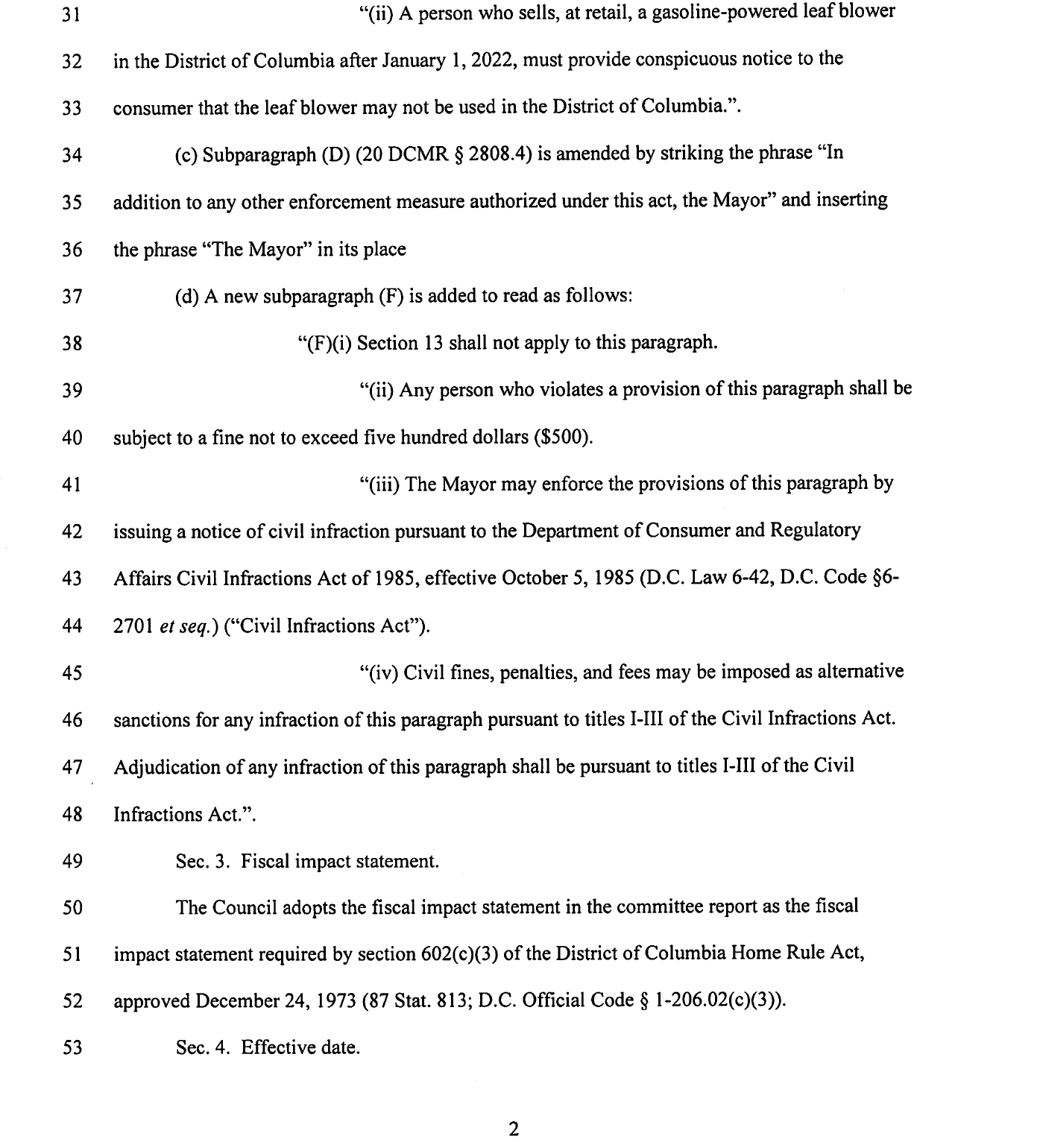An online petition from Change.Org has gathered well over 500 signatures, asking Phil Mendelson, Chair of the District of Columbia City Council, to schedule hearings on a bill by councilmember Mary Cheh that would phase out hyper-polluting, noisy two-stroke gas-powered lawn equipment in the nation's capital. You can read the petition, or add your signature, here.
Meanwhile, the Council's Committee on Housing and Neighborhood Revitalization, chaired by council member Anita Bonds, held a roundtable today on “Quality of Life and Noise in Your Neighborhood.” Ruth Caplan, an environmentalist and civic leader who is part of the of the QCDC organization, submitted testimony about the effects of noise on individual and community health, especially noting the environmental-justice aspects. For instance:
Please also think about the workers who are operating those machines. They’re not 50 or 70 feet away from the source of the noise, as the ratings-based numbers contemplate. Their ears are no more than three or four feet away....
And think some more about those workers. They’re typically first-generation Americans who occupy a fragile foothold in our economy and society, far from the top. They’re ambitious, hard-working, and reliable, but they frequently lack language skills; they may not fully comprehend the risks associated with the equipment that they’re using; they commonly fail to have access to, or use, hearing protection which would help mitigate the damage if used properly; and, in any event, they normally lack sufficient job security to enable them to assert their rights to work under safer conditions.
__________
Statement by Ruth Caplan for Quiet Clean DC, Submitted to the D.C. City Council’s Committee on Housing and Neighborhood Revitalization’s Community Roundtable:“Quality of Life and Noise in Your Neighborhood”
December 11, 2017
Thank you, Chairwoman Bonds and Members of the Committee on Housing and Neighborhood Revitalization. We’re grateful to you for convening this Community Roundtable to consider the under-appreciated issue of noise and its effects on our health, our environment, and our enjoyment of living and working in this great city.
Thank you for this opportunity to present testimony on behalf of Quiet Clean DC --QCDC for short.
My name is Ruth Caplan. I’m a former Executive Director of Environmental Action and of the Environmental Action Foundation, created by the organizers of Earth Day 1970. I’ve lived in Washington for 35 years, and I’ve worked with my neighbors over many years to improve the quality of life in our city. I’m currently President of the Cleveland Park Citizens Association, and have been on the Board of the Association for the past eight years. I care deeply about our city and its citizens . . . your neighbors and mine. I know you do, too; which is why you’ve convened this Community Roundtable to talk about noise. It’s an opportunity that we at QCDC welcome.
I’m a member of the QCDC leadership group. QCDC was formed over two years ago by D.C. residents who are concerned about the proliferation of fossil-fuel-burning leaf blowers. Specifically, QCDC is disturbed by the impact of gas blowers on our public health. We want to protect everyone’s right to live, work, and play in an environment that’s free from invasive and damaging noise. We want to improve the quality of the air we breathe. And we want to provide social, economic, and environmental justice for those of our neighbors whose job it is to operate machinery that’s causing documented harms to their health.
QCDC is led by a number of prominent members of our community. James Fallows, the well-known writer for The Atlantic, whose commentaries are frequently heard and seen on radio and television, is one of our founders. Counted among our leadership group are current and former Advisory Neighborhood Commissioners, a former official of the Environmental Protection Agency, lawyers, educators, writers, and other professionals.
We at QCDC initially were motivated to address the leaf blower problem because of the aggressive noise that over the past several years has become widespread and nearly year-round. As we began to investigate the problems associated with gas-fueled blowers, we discovered how harmful their operation is to our hearing and our health. One of the first lessons we learned is that the damage that gas blowers cause isn’t nearly understood or appreciated to the full extent it should be.
Today’s Community Roundtable is focused on noise. For that reason, this Statement will likewise concentrate on the auditory component of the gas blower problem. But for a more complete understanding of the other components of the problem – they include the health impacts of the dispersal of toxic materials into our breathable airspace; spillage of petroleum products and waste into our streets, lawns, and public spaces; and spewing of dangerous hydrocarbons and other pollutants into the environment -- let me refer you to QCDC’s web site QuietCleanDC.com.
For those who share our concern about this problem, rest assured that steps are being taken to address it. As you know Chairman Bonds, a bill, B22-0234, has been introduced in the Council of the Whole by Council Member Cheh, with sponsorship from yourself and from Council Members Grosso, McDuffie, and Allen. The bill would ban the sale and use of gas-burning leaf blowers in our city by January 1, 2022. The bill is awaiting a hearing before the Committee of the Whole in order to move forward and public pressure is building for the hearing to be held.
QCDC wants to take this occasion to thank you, Chairwoman Bonds, for your support of the bill. We also thank all of the other sponsors of the bill, and the several other Council Members who’ve assured us of their support for the bill.
So, what about the noise problem? How serious is it, and what role do gas-powered leaf blowers play?
Our research into the issue discloses the following salient facts:
- · Gas-powered leaf blowers, especially the ones used by commercial lawn-service contractors -- most of them located in suburban Virginia or Maryland -- typically operate at decibel levels in the 80s, 90s, and above. Those ratings are measured at a substantial distance from the leaf blower when it’s in operation. The noise levels at the ears of the operator, just a few feet from the blower itself, are substantially higher.
- · Federal workplace safety authorities have declared that 85 decibels, measured on what’s called the “A” scale, is the upper limit of safe human exposure to on-the-job noise. However, that standard doesn’t take into account the length of exposure, nor does it consider exposure on the part of workers when they’re not in the workplace.
- · A study published by Harvard University’s T. C. Chan School of Public Health states that for children, whose sensory and neural systems are still developing, the limit of safe noise exposure in an outdoor setting is 55 decibels . . . substantially below the workplace limit of 85 decibels.
- · Because decibels are measured logarithmically, a sound recorded at 85 decibels has over 30 times the energy of a sound measuring 70 decibels. So, what may appear to be relatively small incremental increases in decibel levels are in fact substantial increases in the impact upon the human organism.
- · That same Harvard University study pointed out that the gas-burning leaf blower uniquely generates lower-frequency noise that travels farther than the blower’s middle-frequency and higher-frequency products. The report concludes that these lower-frequency products aren’t adequately measured by the “A” scale that’s commonly used in noise research.
Further evidence comes from the Federal Centers for Disease Control which has recently published findings that hearing loss is the third most chronic health condition in the United States today.
- · According to the CDC, almost twice as many people report suffering from hearing loss as report suffering from diabetes or cancer. Significantly, the CDC reports that noise exposure away from one’s job can be as damaging as working in a noisy workplace.
- · In fact, to quote from the CDC report: “Being around too much loud noise—like using a leaf blower or going to loud concerts—can cause permanent hearing loss. And once it’s gone, you can’t get it back!” [Emphasis added] In addition, according to the CDC, about 20% of adults who suffer from hearing loss have no job-related exposure to loud sounds; they’re getting it from the environment around them, other than where they work. Leaf blowers are a major contributor to that environment.
- · As it relates to health, the CDC reports that continued exposure to loud noise can cause hearing loss, high blood pressure, heart disease, stress, anxiety, and depression.
- · How does this all relate to the gas-powered leaf blower? That same CDC report concludes that as little as two hours of exposure to a leaf blower operating at 90 decibels can cause hearing damage. Remember what I said at the outset: many gas-burning leaf blowers operate above the 85-decibel level . . . that’s measured at a substantial distance. And without regard to the length of the exposure.
So, please think again about yourself or your neighbor: you’re walking past a group of workers operating two, three, or four gas blowers in your immediate vicinity. When multiple blowers are operating simultaneously, each one of them at or above the 85-decibel level, possibly substantially above that level, can you be certain that even a brief exposure won’t cause you some harm? Are you far enough away from them to avoid damage? How long are you exposed to that level of ear-shattering noise? How many blowers are operating, at what decibel level, individually and collectively? Most especially, collectively?
Most important, this hearing is especially concerned about seniors, persons with disabilities, and others with illness and life threatening medical conditions regarding the effects that neighborhood noise can have on the quality of the life of those residents living in an urban environment. For seniors aging in place or in a long-term care facility, they cannot just walk away from this noise. Persons with disabilities are hampered in moving quickly away from the noise. And those already suffering from medical conditions will be doubly impacted by the health hazards arising from the micro particles emitted by gas-powered leaf blowers.
Please also think about the workers who are operating those machines. They’re not 50 or 70 feet away from the source of the noise, as the ratings-based numbers contemplate. Their ears are no more than three or four feet away. So, a gas blower whose decibel rating is 85 – measured from a significant distance – will actually be producing substantially higher levels of energy at the ear of the operators; substantially in excess of 85 decibels. And for hours and hours on end, every work day. Remember what the CDC said about that. These unfortunate people are causing themselves enormous harm, simply from the noise component. (Again, today we’re not addressing the other, non-auditory harms from the operation of gas-burning leaf blowers.)
And think some more about those workers. They’re typically first-generation Americans who occupy a fragile foothold in our economy and society, far from the top. They’re ambitious, hard-working, and reliable, but they frequently lack language skills; they may not fully comprehend the risks associated with the equipment that they’re using; they commonly fail to have access to, or use, hearing protection which would help mitigate the damage if used properly; and, in any event, they normally lack sufficient job security to enable them to assert their rights to work under safer conditions.
Thank you, again, Chairwoman Bonds and Members of this Committee, for this opportunity to present our concerns. We look forward to continuing a dialogue with you and your staff as we move toward a safer, healthier, quieter, greener, and more equitable community to live, work, and enjoy.












